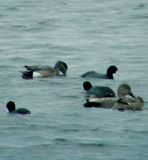| Contact us |
| Try wildfowling |
| Club merchandise |
| Wildfowl art |
| Wildfowling books |
| Join KWCA |
| Search |

Windless Evening Flight
by Alan Jarrett
One of the drawbacks of pre-planned shooting trips is that you are entirely
at the mercy of the weather - come rain or shine off you go, and hope
for the best. However, I have long since learnt with wildfowling that
'ideal' conditions do not always produce the best sport.
So it was that I paddled with little enthusiasm into a side creek off
the main channel. The sky was virtually clear, whilst there was scarcely
a breath of wind.
Here, given those 'ideal'conditions, there was every likelihood of a few
shots, but on such an evening as this prospects were not too good. Yet,
ever the optimist I knew that it only takes a few seconds to come up trumps.
EARLY CHANCE
At length I lay up in ambush in a tiny runnel into the saltings, barely
deep enough to accommodate the 16-foot punt. Opposite there was the barest
remnant of a splash left by the last big tides, and it was to this focal
point that I hoped any birds might come.
I sat in the punt and drank coffee, idly running my thoughts back over
a fruitful tide flight on the day before, when a pair of wigeon bore down
on me. As the gun was still in its sleeve under the decking they went
on their way unmolested, and even if I did desperately draw out the gun
and thereafter keep it close at hand no more duck came.
WONDERFUL SKY
Us wildfowlers are a romantic bunch being much fascinated by the world
around us, as well as the birds themselves. Most certainly on this pleasant
December afternoon there was much to slake the thirst for nature ís
beautiful things.
Across part of the sky to the north there was a marvelous pattern commonly
and effectively described by many artists as a mackerel ski. This time
it was ridges of thin white cloud against a deepening blue, and it was
made all the more wonderful by the sedate passage of four whooper swans
on their way to their roost.
High up towards the east a curious series of grey brush strokes of cloud
reminded me of something. After some thought I determined it to resemble
the light flick of a partridgeswing against the blue.
At the top of the tide small parties of curlew quartered about the saltmarsh,
some coming to the splash before making off in alarm. Others still passed
across the point of an island, where almost 20 years before on a September
evening at least as balmy as this I had inflicted great slaughter on them.
FADING LIGHT
At length the light began to draw in rapidly. It was one of those evenings
when the light would be bound to hang on in the west for an eternity;
but I had to face the blackness to the east, and the tide was going out
in a hurry.
A pair of wigeon circled the saltmarsh, before disappearing into the gloom.
They had seemed half-interested in the area, and I suddenly had a good
feeling come over me that sharpened the senses and made me study the inky
eastern sky with extra intensity.
Another pair of wigeon dropped down into the tide a long way off. Then
a great host of curlew and shelduck were scattered by a hen harrier that
passed between me and the red sky in the west as it sought a last late
meal before bedtime!
Four black shapes appeared out of the eastern sky, dropping slowly it
seemed to the splash. Even at a good range I fired before they were right
down, and only three turned away.
I sent the dog and at length she got into the splash ñ which I
knew to be only an inch or two deep ñ and a fearful chase ensued
as she tried to catch the bird. At length after three loud sprints through
the splash she returned with a hen wigeon.
Soon after another pair came right to me out of the gloom. They seemed
to be flying so slowly, but I knew better for I had been fooled many times
before by such an illusion.
Anyone who has watched descended duck from afar will be left in no doubt
that they drop very rapidly indeed. The wily wildfowler needs to remember
this at all times ñ especially when the light is all but gone and
it is difficult to judge range and speed.
So I moved the gun quickly below the first bird and it folded into a ball.
The second bird climbed away, and I plucked it out with the third shot
- a cock and hen wigeon to add to the first.
Further drama as a single bird came on the same line. It fell to my second
shot onto the salting behind -another cock bird.
Then it was into the punt and a desperate scramble to get out before the
tide left me trapped. It was a case of bumping muddy ridges and pushing
with the paddle before I was in deep water and heading home.
What a marvelous evening. The channel was without a ripple as I nonchalantly
paddled back - once again less than 'ideal' conditions had demonstrated
that when you can get out onto the foreshore you most definitely should.